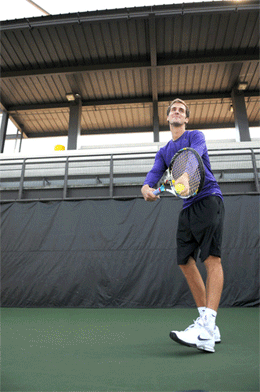Just like Adam Sandler before a putt in “Happy Gilmore,” tennis players need to find their “happy place” before serving.
Players develop a sort of habit over years of playing tennis, and the pre-serve ritual is what they fall back on when preparing themselves for the match to come.
The first noticeable thing about many of the pre-serve routines is the bounce.
“I always bounce the ball three to four times before every serve,” said LSU senior tennis player Mark Bowtell. “It’s just become a ritual.”
The bounce allows players to collect themselves after a point. The time before the serve is meant to calm the player and get him or her ready for the next point.
“I try to mentally map out how you want the next point to go,” said LSU senior tennis player Stefan Szacinski. “I might not get the whole thing right, but preparing myself for the next couple shots is crucial. You may be frustrated after an unforced error, but you have to settle yourself before starting the next point.”
LSU players are given scouting reports before each match on where their opponents’ weaknesses are, specifically which of their opponents’ shots — forehand or backhand — is the weakest.
Szacinski said his serving plan is based on the scouting reports, and he tries to vary where he places his serves depending on how the match is going.
Once a player sets the amount of bounces before a serve, it helps to stick to the routine.
“If you normally do six bounces and you only do three, you might feel like you’re rushing yourself,” said LSU coach Jeff Brown. “If you do too many, you might overthink it.”
The only thing that changes between a player’s first and second serve is the amount of time he or she has to plan out the upcoming point.
While most first serves are based on trying to hit a specific spot on the court with as much speed as possible, the second serve focuses on spin and not giving the opponent anything to capitalize on.
“You want the racket speed to be the same,” Brown said. “But it is kind of like a curveball in the sense that while it may not be as fast, the movement and the placement don’t allow the other player to really tee off on it.”
After the bounce comes the breath.
Like a sniper before taking a shot, tennis players breathe in before firing and exhale as they are about to unleash a serve.
Brown said the grunts and screams associated with the serve are actually a habit the players develop to perfect their breathing routines.
Players are trained to breathe out as they strike through the ball to make their bodies as loose as possible, which ensures the cleanest strike of the ball.
“The breathing is key,” Brown said. “You want to start slow and build toward a faster speed so that when you are ready to serve, you explode upward.”
Most sports have ritualistic players, but tennis players’ entire matches are based on their pre-serve rituals.
“It’s all basically a superstition,” said LSU women’s tennis coach Julia Sell. “You should be able to tell who is serving without looking at their face. Just looking at the routine you should be able to tell.”

photos by Connor Tarter




